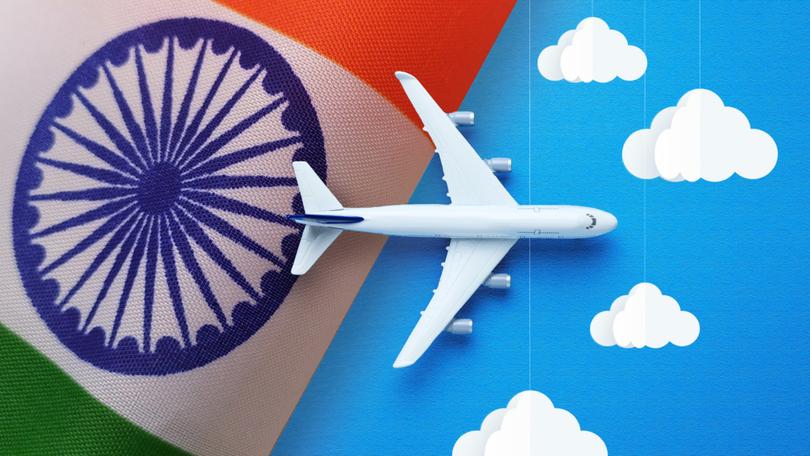The Economist: Why Indian tourists are finally conquering the world

Indian Express on a Friday evening is always bustling. Diners from all corners of India dig in to kebabs and curries. Kingfisher, an Indian lager, flows freely, and Bollywood music blares from the speakers. A similar (if slightly more abstemious) scene plays out down the road at Radha Krishna, a vegetarian eatery.
One might be in any of a dozen cities in India. But this paratha party is happening in Bangkok.
India’s economic rise has lifted millions out of poverty and given the country greater geopolitical heft. Less obvious is the effect of its growing consumer class on other countries. International departures from India more than doubled, to 27 million, in the decade to 2019. Overseas spending by Indian travellers tripled between 2010 and 2023, to $US33 billion ($50b). One forecast suggests it will jump to $US45b ($67b) next year.
Sign up to The Nightly's newsletters.
Get the first look at the digital newspaper, curated daily stories and breaking headlines delivered to your inbox.
By continuing you agree to our Terms and Privacy Policy.Driving this is a mix of demography and economics. People aged between 25 and 34 are the most keen on travel; a fifth of the population will age into that group soon. The middle class is expected to be twice as big by 2047. The number of valid Indian passports grew from 52 million a decade ago to 93 million this year.
By 2040 the number of international departures could hit 80 million or even 90 million, reckons McKinsey, a consultancy. That is not far off the 104 million Chinese who went abroad in 2019 But Chinese consumers are increasingly staying at home; their foreign travel is not growing as fast as it used to.
Indians are thirsty to see the world. Unlike the Chinese at a similar stage, however, they are not rushing to Europe. It is countries closer to home that are reaping the rewards.
In recent decades, as China became the world’s biggest source of tourists, Western countries adjusted. Governments simplified visa processes, airports installed signage in Mandarin, and shops started accepting Chinese payment platforms.
But they have been slower to court Indian tourists. Meanwhile, Middle Eastern and South-East Asian countries are racing ahead. Thailand and Malaysia have suspended visa requirements for Indians. Other countries are recruiting Bollywood stars as brand ambassadors: Abu Dhabi tourism has landed Ranveer Singh, who used to promote Switzerland; Dubai has roped in Saif Ali Khan and Sara Ali Khan, a father-and-daughter duo. The countries that welcome Indians will enjoy both the economic benefits and the cultural soft power that tourism affords.
For lessons on how to do it, look to the South-East Asian countries that were early to grasp India’s potential. They are now redoubling their efforts in hopes of replacing China’s flagging numbers. In 2019 Chinese accounted for 11 million of Thailand’s 40 million overseas visitors. Last year they were a mere 3.5 million out of 28 million.
Indians, on the other hand, keep coming. A decade ago around 1 million visited annually; that level was already reached in the first half of 2024. Many are on their inaugural trip abroad. Margaux Constantin of McKinsey thinks Bangkok could take over from Dubai as Indians’ number-one leisure destination this year. Thailand’s tourism ministry estimates that Indians generated 63 billion baht ($2.6b) in 2023, or around 0.4 per cent of Thai GDP.
Thailand appeals to Indians because it is cheap, easy to get to and welcoming. The last point is most important. The Indian passport is a weak document, providing visa-free or equivalent entry to just 58 countries, mostly small islands in the Pacific and Caribbean. Even Cubans and Belarusians have better access to the world.
Last year Thailand lifted all visa requirements for Indians, a privilege usually reserved for rich Western countries. Visitor numbers immediately shot up. Iran, Kenya and Sri Lanka have also abolished visas for Indians. More modest loosening helps, too. When Azerbaijan launched an e-visa programme for Indians in 2017, annual arrivals tripled within a year and doubled again the next year, to 160,000.
Rich Western countries, on the other hand, make Indians feel unwanted. Waiting times for American tourist-visa interviews can be longer than a year. Britain’s visa fees are extortionate. Getting a visa for Europe’s border-free Schengen zone, if an appointment can be found, requires stacks of paperwork, evidence of financial health and proof of intention to return. Many travellers find it humiliating. Some refuse to go.
“It’s too painful a process to go through for a visa you may or may not get and if you do get it, it’s for the exact duration of stay,” says a Bangalore-based professional who works for a European firm. He prefers South-East Asia.
Last year 19 per cent of Indian applications for a British visit visa were rejected, as were 15 per cent of applications for the Schengen region.
“By design or otherwise, they’re losing out,” says Rajesh Magow, the boss of MakeMyTrip, India’s biggest online travel agent.
Moreover, Indians tend to be last-minute travellers. Britons book international trips three months in advance, on average, and Americans two months. Indians do so barely 30 days earlier. That is not enough time to get a visa to Europe or North America.
Indians still travel to America and Britain in big numbers, largely to see friends and family in the huge Indian diaspora; visa problems make them less appealing as holiday destinations. Europe performs even worse. No country in the Schengen region is among the top ten destinations for Indians except France, which comes seventh. Germany and Italy rank below Kuwait and Qatar. Europeans worried about overtourism can rest easy; Indians are taking their rupees elsewhere.
After visas, the biggest factor influencing where Indians decide to go is the ease of getting there. Direct flights have surged: 31 Indian cities now offer international flights to 322 destinations, up from 23 and 272 in 2015.
“Foreign airports are knocking at our doors pretty much every other day,” says Pieter Elbers, the boss of IndiGo, India’s largest airline.
These numbers, too, are poised to take off. WizzAir, a European budget airline, is considering introducing direct flights to India. AirAsia, based in Malaysia, just added its 17th Indian destination. VietJet, a Vietnamese low-cost carrier, has expanded beyond Mumbai and Delhi to smaller Indian cities.
“Vietnam’s fortunes changed because it got connectivity,” says Neil Patil of Veena World, a tour operator. Two years ago there were barely any direct flights. Today there are more than 200 every month. Arrivals from India have jumped nearly ten-fold to 30,000 a month.
The effect is even greater when an Indian airline launches a direct route, says Binit Somaia of CAPA India, an aviation consultancy. They have broader sales bases and bigger domestic marketing budgets. Indian tourist arrivals to Turkey grew by 50 per cent after IndiGo started daily nonstop flights to Istanbul in 2019. It recently started flying to Central Asia and the Caucasus. Uzbekistan’s cities quickly filled up with Indian tourists.
Carriers are adding foreign destinations at a quick clip. Akasa Air, just two years old, operated only domestically six months ago. Now it flies to five international destinations. IndiGo and Air India, the flag carrier, are ordering dozens of new wide-body aircraft. In total, Indian carriers have some 1,500 planes on order. Next year Mumbai and Delhi will each get a second international airport.
The third major consideration is cost. Indians’ budget-conscious habits have led travel firms to innovate in making trips cheaper. Agencies such as MakeMyTrip offer discounts and coupons galore. Many tie up with banks to offer credit: around a fifth of urban Indians who took out a personal loan did so for leisure travel, according to a survey in 2023.
Moreover, as India itself gets pricier, other places start to look like a bargain. At peak times Thailand offers better value than Goa, India’s beach-and-booze state.
The number of people with cash to spare is growing, too. Those with household incomes of over $US10,000 are less price-sensitive, says Mr Magow. Goldman Sachs, a bank, estimates that some 60 million individuals make at least that much. Another 40 million are likely to join them by 2027. CAPA India is even more optimistic: it thinks more than half of Indian households will have incomes over $US10,000 by 2030.
One European(ish) country that is focusing on Indian travellers is Russia, where visitors from the West have dwindled. It sees India as a “prime” market and its government is said to be negotiating bilateral visa-free access.
Other countries whose tourism boards are actively wooing Indians tend to be far from Europe: places like Kenya and Australia. Saudi Arabia hopes to attract 7.5 million Indians by 2030, up from 1.5 million last year.
Apart from visas, flights and prices, winning more Indian tourists has to do with the sort of cultural pitch a country makes. Middle Eastern countries promise shopping — with discounts — and adventure activities. Thailand, eager to shed its reputation as a drinking and sex-tourism destination, is targeting solo women and high-spending wedding groups.
The bets on Bollywood go beyond getting stars as brand ambassadors: countries compete to host the filming of Indian movies and television shows. Switzerland is still benefiting from a spate of Bollywood movies shot there in the 1990s. Singapore’s tourism board encourages producers to film in the city-state.
A paneer of respectability
A final question is the availability of Indian food — especially vegetarian. It is the top concern for many outbound travellers.
In March Ankesh Kanuga, a 43-year-old pharmacist in Mumbai, made his first trip overseas, to Azerbaijan. Over four days Mr Kanuga and a dozen friends skied, visited historical sites and sampled the nightlife for a total cost of about 90,000 rupees ($1600) each. His chief complaint was the lack of Indian restaurants and vegetarian food. Still, Mr Kanuga says he would like to go abroad “again and again”.
Tens of millions of Indians feel the same way.
Some denizens of rich countries may not be sorry to hear that Indians are not coming to visit. Overtourism has become a bogeyman in many places, especially European cities.
But the consequences of turning away visitors from a huge rising power go beyond economics. Tourism shapes global culture; it helps determine which places are seen as important and which are overlooked. Even at its most superficial, it builds personal connections between countries. It is easier to hold prejudices about places one has never seen.
The countries that invest in attracting Indians will shape the mental geography and implicit alliances of the future. At the moment, it is South-East Asia and the Middle East that are doing so. America and Europe are missing out, as are the Indians who would like to see them.
